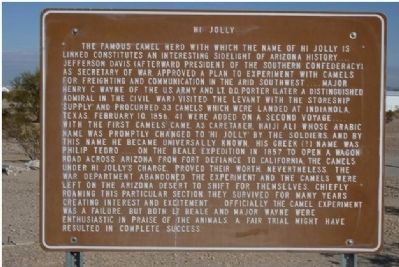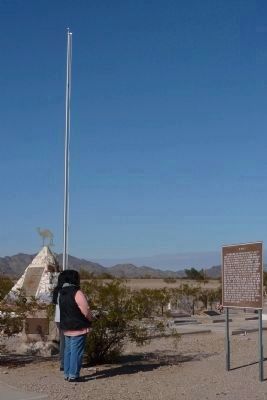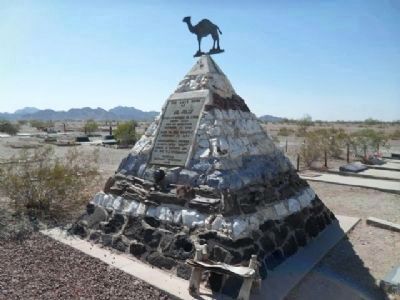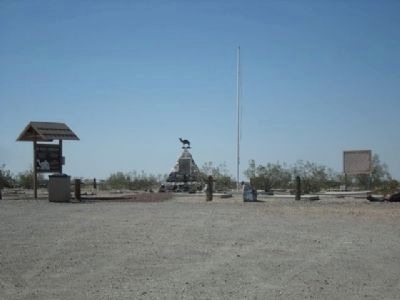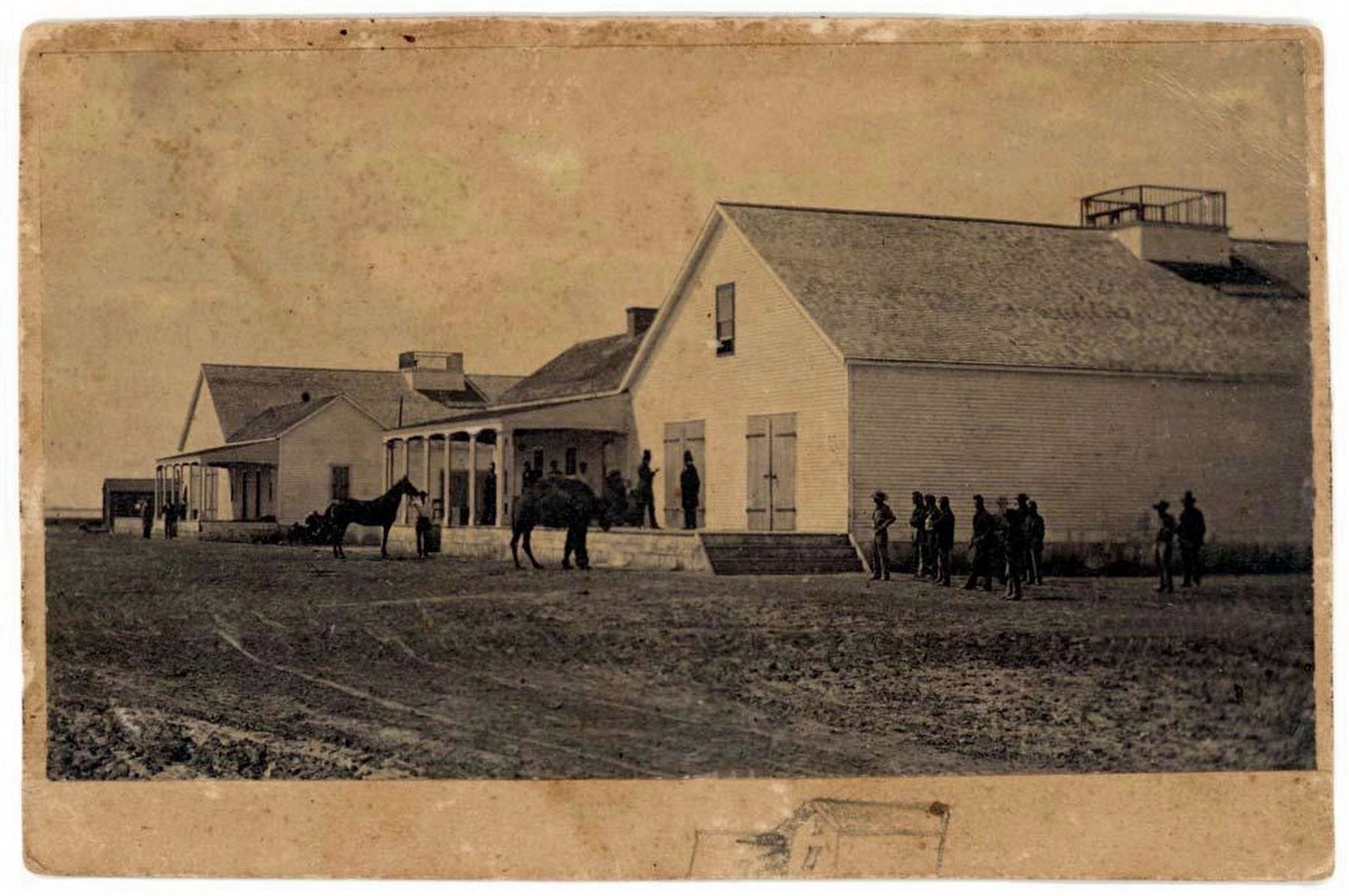Quartzsite in La Paz County, Arizona — The American Mountains (Southwest)
Hi Jolly
Jefferson Davis (afterward president of the Southern Confederacy), as Secretary of War, approved a plan to experiment with camels for freighting and communication in the arid southwest.
Major Henry C. Wayne of the U.S. Army and Lt. D.D. Porter (later a distinguished admiral in the Civil War) visited the Levant with the storeship "Supply" and procured 33 camels which were landed at Indianola, Texas, February 10, 1856. 41 were added on a second voyage.
With the first camels came, as caretaker, Haiji Ali whose Arabic name was promptly changed to "Hi Jolly" by the soldiers. And by this name he became universally known. His Greek (?) name was Philip Tedro.
On the Beale Expedition in 1857 to open a wagon road across Arizona from Fort Defiance to California, the camels under Hi Jolly's charge, proved their worth. Nevertheless, the War Department abandoned the experiment and the camels were left on the Arizona Desert to shift for themselves. Chiefly roaming this particular section, they survived for many years creating interest and excitement.
Officially the camel experiment was a failure, but both Lt. Beale and Major Wayne were enthusiastic in praise of the animals. A fair trial might have resulted in complete success.
Topics. This historical marker is listed in these topic lists: Animals • Military. A significant historical date for this entry is February 10, 1581.
Location. 33° 39.846′ N, 114° 14.156′ W. Marker is in Quartzsite, Arizona, in La Paz County. Marker can be reached from Hi Jolly Road, ¼ mile north of Quartzsite Boulevard. Hi Jolly Road is at the west end of Quartzsite. Turn right and head north to the Hi Jolly Cemetery. Look for the flagpole. Touch for map. Marker is in this post office area: Quartzsite AZ 85346, United States of America. Touch for directions.
Other nearby markers. At least 6 other markers are within 14 miles of this marker, measured as the crow flies. The Last Camp of Hi Jolly (within shouting distance of this marker); Tyson's Well (approx. 0.9 miles away); Oasis Hotel Site (approx. 0.9 miles away); a different marker also named Tyson's Well (approx. one mile away); Phantom II (approx. 1.8 miles away); Quinn Pass (approx. 13.3 miles away).
More about this marker. This sign/marker is adjacent to the Hi Jolly grave.
Regarding Hi Jolly. The more one digs into the Army Camel Experiment, the more fascinating it becomes. The personalities involved, the layers of facts and somewhat facts, the stories of not only the camel drivers, but the camels themselves. It becomes
an interesting twist in the histories of the southwest and Mexico, and the beginning of further camel experimentation for commerce. Yiorgos Caralambo and Elias Calles enter history's picture, and the camel maze makes further twists and turns with these men's personal histories.
Related markers. Click here for a list of markers that are related to this marker. The Last Camp of Hi Jolly has pictures and more references to the Great Southwest Camel Experiment
Also see . . .
1. An Izmiri Camel Herder in The Wild West. A Turkish point of view and history and yet another spelling for Hi Jolly's name. (Submitted on June 27, 2010, by Chris English of Phoenix, Arizona.)
2. Greek George, Giorgio Caralambos Wiki. This wiki page provides more detail on the camel experiment and the people participating. There is no specific web page, but Elias Calles fathered a president of Mexico and a search on Plutarco Elías Calles brings up Mexican history, shaped by the camels of the southwest. (Submitted on June 27, 2010, by Chris English of Phoenix, Arizona.)
3. Wikipedia entry for the United States Camel Corps. “Robert E. Lee, who was still a U.S. Army officer and temporary commander of the Department of Texas, ordered Lieutenant William E. Echols on another reconnaissance between Camp Hudson and Fort Davis; part of Echols’s mission was to locate a site for a camp near the Comanche. The train consisted of 20 camels, of which only one was a male, and 25 mules. On June 24, the expedition, which was joined by an infantry escort commanded by Lieutenant J. H. Holman, marched from Camp Hudson toward the Pecos Rover. The camels again performed better than the mules did. As the march continued through extremely dry country, Echols feared for the lives of his men and the animals. On the fifth day, the party reached San Francisco Creek, a tributary of the Rio Grande, with almost no water left. Three mules died on this leg of the journey; all of the camels survived. After resting for a day at a waterhole, Echols led his command to Fort Davis. Echols decided that one man and nine mules had to be left at Davis because they were unable to continue. On July 17, the expedition arrived at Presidio del Norte near the Rio Grande. Echols found what he believed to be a suitable location for a camp. The expedition returned through Fort Stockton to Camp Hudson, arriving in early August. The detachment was released to its home post and the camels were returned to Camp Verde. Lee wrote to Adjutant General Samuel Cooper ‘...of camels whose endurance, docility and sagacity will not fail to attract attention of the Secretary of War, and but for whose reliable services the reconnaissance would have failed.’ The reconnaissance ordered by Lee was the last long-range use of the camels before the outbreak of the Civil War.” (Submitted on February 10, 2018.)
Credits. This page was last revised on December 20, 2020. It was originally submitted on June 27, 2010, by Chris English of Phoenix, Arizona. This page has been viewed 2,386 times since then and 60 times this year. Last updated on December 3, 2013, by James King of San Miguel, California. Photos: 1. submitted on June 27, 2010, by Chris English of Phoenix, Arizona. 2. submitted on December 12, 2009, by Chris English of Phoenix, Arizona. 3, 4. submitted on June 9, 2012, by Denise Boose of Tehachapi, California. 5. submitted on February 10, 2018, by J. J. Prats of Powell, Ohio. • Bill Pfingsten was the editor who published this page.
